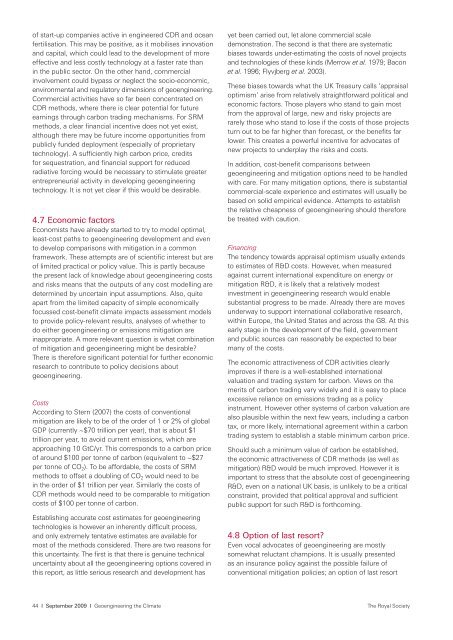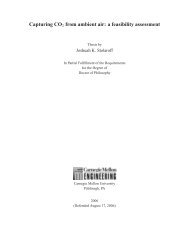Royal Society - David Keith
Royal Society - David Keith
Royal Society - David Keith
You also want an ePaper? Increase the reach of your titles
YUMPU automatically turns print PDFs into web optimized ePapers that Google loves.
of start-up companies active in engineered CDR and ocean<br />
fertilisation. This may be positive, as it mobilises innovation<br />
and capital, which could lead to the development of more<br />
effective and less costly technology at a faster rate than<br />
in the public sector. On the other hand, commercial<br />
involvement could bypass or neglect the socio-economic,<br />
environmental and regulatory dimensions of geoengineering.<br />
Commercial activities have so far been concentrated on<br />
CDR methods, where there is clear potential for future<br />
earnings through carbon trading mechanisms. For SRM<br />
methods, a clear financial incentive does not yet exist,<br />
although there may be future income opportunities from<br />
publicly funded deployment (especially of proprietary<br />
technology). A sufficiently high carbon price, credits<br />
for sequestration, and financial support for reduced<br />
radiative forcing would be necessary to stimulate greater<br />
entrepreneurial activity in developing geoengineering<br />
technology. It is not yet clear if this would be desirable.<br />
4.7 Economic factors<br />
Economists have already started to try to model optimal,<br />
least-cost paths to geoengineering development and even<br />
to develop comparisons with mitigation in a common<br />
framework. These attempts are of scientific interest but are<br />
of limited practical or policy value. This is partly because<br />
the present lack of knowledge about geoengineering costs<br />
and risks means that the outputs of any cost modelling are<br />
determined by uncertain input assumptions. Also, quite<br />
apart from the limited capacity of simple economically<br />
focussed cost-benefit climate impacts assessment models<br />
to provide policy-relevant results, analyses of whether to<br />
do either geoengineering or emissions mitigation are<br />
inappropriate. A more relevant question is what combination<br />
of mitigation and geoengineering might be desirable?<br />
There is therefore significant potential for further economic<br />
research to contribute to policy decisions about<br />
geoengineering.<br />
Costs<br />
According to Stern (2007) the costs of conventional<br />
mitigation are likely to be of the order of 1 or 2% of global<br />
GDP (currently ~$70 trillion per year), that is about $1<br />
trillion per year, to avoid current emissions, which are<br />
approaching 10 GtC/yr. This corresponds to a carbon price<br />
of around $100 per tonne of carbon (equivalent to ~$27<br />
per tonne of CO 2 ). To be affordable, the costs of SRM<br />
methods to offset a doubling of CO 2 would need to be<br />
in the order of $1 trillion per year. Similarly the costs of<br />
CDR methods would need to be comparable to mitigation<br />
costs of $100 per tonne of carbon.<br />
Establishing accurate cost estimates for geoengineering<br />
technologies is however an inherently difficult process,<br />
and only extremely tentative estimates are available for<br />
most of the methods considered. There are two reasons for<br />
this uncertainty. The first is that there is genuine technical<br />
uncertainty about all the geoengineering options covered in<br />
this report, as little serious research and development has<br />
yet been carried out, let alone commercial scale<br />
demonstration. The second is that there are systematic<br />
biases towards under-estimating the costs of novel projects<br />
and technologies of these kinds (Merrow et al. 1979; Bacon<br />
et al. 1996; Flyvjberg et al. 2003).<br />
These biases towards what the UK Treasury calls ‘appraisal<br />
optimism’ arise from relatively straightforward political and<br />
economic factors. Those players who stand to gain most<br />
from the approval of large, new and risky projects are<br />
rarely those who stand to lose if the costs of those projects<br />
turn out to be far higher than forecast, or the benefits far<br />
lower. This creates a powerful incentive for advocates of<br />
new projects to underplay the risks and costs.<br />
In addition, cost-benefit comparisons between<br />
geoengineering and mitigation options need to be handled<br />
with care. For many mitigation options, there is substantial<br />
commercial-scale experience and estimates will usually be<br />
based on solid empirical evidence. Attempts to establish<br />
the relative cheapness of geoengineering should therefore<br />
be treated with caution.<br />
Financing<br />
The tendency towards appraisal optimism usually extends<br />
to estimates of R&D costs. However, when measured<br />
against current international expenditure on energy or<br />
mitigation R&D, it is likely that a relatively modest<br />
investment in geoengineering research would enable<br />
substantial progress to be made. Already there are moves<br />
underway to support international collaborative research,<br />
within Europe, the United States and across the G8. At this<br />
early stage in the development of the field, government<br />
and public sources can reasonably be expected to bear<br />
many of the costs.<br />
The economic attractiveness of CDR activities clearly<br />
improves if there is a well-established international<br />
valuation and trading system for carbon. Views on the<br />
merits of carbon trading vary widely and it is easy to place<br />
excessive reliance on emissions trading as a policy<br />
instrument. However other systems of carbon valuation are<br />
also plausible within the next few years, including a carbon<br />
tax, or more likely, international agreement within a carbon<br />
trading system to establish a stable minimum carbon price.<br />
Should such a minimum value of carbon be established,<br />
the economic attractiveness of CDR methods (as well as<br />
mitigation) R&D would be much improved. However it is<br />
important to stress that the absolute cost of geoengineering<br />
R&D, even on a national UK basis, is unlikely to be a critical<br />
constraint, provided that political approval and sufficient<br />
public support for such R&D is forthcoming.<br />
4.8 Option of last resort?<br />
Even vocal advocates of geoengineering are mostly<br />
somewhat reluctant champions. It is usually presented<br />
as an insurance policy against the possible failure of<br />
conventional mitigation policies; an option of last resort<br />
44 I September 2009 I Geoengineering the Climate The <strong>Royal</strong> <strong>Society</strong>








